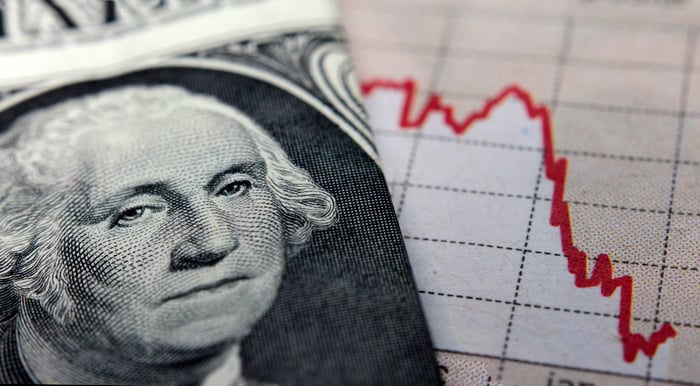One week ago, on Aug. 10, 2023, the U.S. Bureau of Labor Statistics released the much-anticipated July inflation report. Considering how aggressive the Federal Reserve has been with raising rates -- a cumulative 525 basis-point increase in the federal funds target rate since March 2022 -- Wall Street was looking for clear signs of the U.S. inflation rate tapering.
For the past couple of months, the headline figure in the monthly inflation report has signaled progress. Despite a very modest uptick in the U.S. inflation rate in July, as measured by the Consumer Price Index for All Urban Consumers (CPI-U), a 3.2% rate of inflation is far and away a major improvement from the 9.1% inflation rate reported in June 2022.
While it would appear that the central bank's monetary policy is working as intended, a deeper dive suggests the Fed is actually losing the battle against inflation, with no clear fix in sight.

Image source: Getty Images.
The Fed is stuck between a rock and a hard place, and it has housing to blame
As a headline figure, the CPI-U tells a promising story. However, big problems arise if you focus on core inflation.
"Core inflation" describes every spending category you'd find in the CPI-U, with the exception of food and energy components, which tend to be quite volatile. Although core inflation has declined from its September 2022 peak of 6.6%, the core inflation reading of 4.7% in July 2023 is more than double the 2% rate the Fed is targeting over the long term.
US Core Inflation Rate data by YCharts.
While some core inflation categories are seeing signs of deflation (falling prices), such as medical care services and used vehicles, stubbornly high core inflation can predominantly be traced to rapidly rising shelter costs. Within the CPI-U, "shelter" refers to the rental costs of a primary residence or owners' equivalent rent, if they own their home.
Shelter is, by far, the largest-weighted spending category within the CPI-U and core inflation. It's also the single biggest reason the Fed is fighting a losing battle against inflation.
As of this past weekend, the typical 30-year fixed-rate mortgage in the U.S. was nearly 7%, according to data provided by the Federal Reserve Bank of St. Louis. That's just a few basis points away from a 21-year high.
However, a report issued in June from technology-driven real estate company Redfin found that 91.8% of all homeowners have a mortgage rate that's below 6%. Approximately 62% are locked in at a rate below 4%. There's absolutely no financial incentive for these homeowners to give up their historically low mortgage rate for a new home with a 7% 30-year fixed-rate loan. This is why there's a major shortage of new listings for existing homes.
30 Year Mortgage Rate data by YCharts.
On the other end of the spectrum, renters who'd been considering a home purchase are less likely to get off the proverbial fence. A shortage in new listings is keeping home prices elevated, while higher rates are pricing more and more prospective buyers out of home ownership. This has put the ball completely in the court of landlords and rental communities, which are enjoying incredible rent-pricing power. In July, rent inflation in the U.S. was nearly 7.7%, which is higher than it's consistently been in more than four decades.
In other words, I believe the Fed is in deep trouble. The housing market is effectively frozen by a historic ramp-up in mortgage rates, and landlords/rental communities have exceptional pricing power as a tailwind, with no clear end in sight. That's a recipe for sustained high core inflation, if not a reacceleration of the core inflation rate.
Three smart ways to invest, regardless of whether the Fed is right or wrong
In my opinion, the Fed is fighting a losing battle against inflation, and the only real solution is for Wall Street to "take its medicine" after more than a decade of historically favorable lending practices and record-breaking money-supply expansion during the COVID-19 pandemic.
But regardless of what happens in the coming months or quarters, there are three smart strategies investors can employ to successfully navigate any environment.

Image source: Getty Images.
1. Buy dividend-paying stocks
When uncertainty arises, one of the smartest things investors can do is buy dividend stocks. Companies that pay a regular dividend tend to be profitable on a recurring basis, are usually time-tested, and can offer transparent/predictable long-term outlooks. In other words, they're companies that allow you to sleep easy at night.
Take Johnson & Johnson (JNJ 0.12%) as an example. Johnson & Johnson has raised its base-annual payout for 61 consecutive years and was riding a 35-year streak of growing its adjusted annual-operating earnings that was only thwarted by the COVID-19 pandemic. A higher core inflation rate or troublesome housing market isn't going to impact demand for its brand-name drugs or medical technologies.
2. Seek out businesses that can benefit from a higher rate of inflation
Another smart investing strategy if core inflation remains stubbornly high is to seek out businesses that actually benefit from high inflation.
For instance, payment processors Visa (V 0.16%) and Mastercard (MA -0.20%) often see their fee collection increase when inflation picks up. Although rising prices may cause some consumers to pare back their discretionary spending, the rising cost of basic necessity goods and services means added fees for Visa and Mastercard.
Another example would be debt-focused business development company PennantPark Floating Rate Capital (PFLT 0.91%). The entirety of PennantPark's $950 million debt-investment portfolio sports variable rates. With the Fed intent on keeping interest rates high, PennantPark has enjoyed a 500 basis-point increase in its weighted-average yield on debt investments (7.4% to 12.4%) since Sept. 30, 2021.
3. Own stocks in defensive sectors and industries
Lastly, investors can navigate potentially turbulent waters by purchasing stocks in defensive sectors and industries. By "defensive," I mean sectors and industries that provide basic needs goods and services, or that would be undisturbed by a higher core inflation rate.
Johnson & Johnson, which I mentioned a moment ago, fits the bill. Healthcare companies provide drugs, devices, and/or services that are inelastic. People don't stop needing prescription medicines or medical devices just because the inflation rate has moved to uncomfortable levels. Demand for healthcare products and services tends to be predictable in any economic environment.







